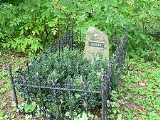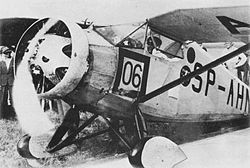
Stanislaw Wigura
Encyclopedia

Poland
Poland , officially the Republic of Poland , is a country in Central Europe bordered by Germany to the west; the Czech Republic and Slovakia to the south; Ukraine, Belarus and Lithuania to the east; and the Baltic Sea and Kaliningrad Oblast, a Russian exclave, to the north...
aircraft designer and aviator, co-founder of the RWD
RWD (aircraft manufacturer)
RWD was a Polish aircraft construction bureau active between 1928 and 1939. It started as a team of three young designers, Stanisław Rogalski, Stanisław Wigura and Jerzy Drzewiecki, whose names formed the RWD acronym.-History:...
aircraft construction team and lecturer at the Warsaw University of Technology
Warsaw University of Technology
The Warsaw University of Technology is one of the leading institutes of technology in Poland, and one of the largest in Central Europe. It employs 2,453 teaching faculty, with 357 professors . The student body numbers 36,156 , mostly full-time. There are 17 faculties covering almost all fields of...
. Along with Franciszek Żwirko, he won the international air contest Challenge 1932
Challenge 1932
The Challenge 1932 was the third FAI International Tourist Plane Contest , that took place between 12 and August 28, 1932 in Berlin, Germany. The four Challenges, from 1929 to 1934, were major aviation events in pre-war Europe.-Overview:...
.
He was born in Warsaw
Warsaw
Warsaw is the capital and largest city of Poland. It is located on the Vistula River, roughly from the Baltic Sea and from the Carpathian Mountains. Its population in 2010 was estimated at 1,716,855 residents with a greater metropolitan area of 2,631,902 residents, making Warsaw the 10th most...
. In his youth he was interested in mechanics and aviation, and he was also a Boy Scout
Zwiazek Harcerstwa Polskiego
Związek Harcerstwa Polskiego is the coeducational Polish Scouting organization recognized by the World Organization of the Scout Movement and the World Association of Girl Guides and Girl Scouts. It was founded in 1918 and currently is the largest Scouting organization in Poland...
. In 1920, during the Polish-Soviet War
Polish-Soviet War
The Polish–Soviet War was an armed conflict between Soviet Russia and Soviet Ukraine and the Second Polish Republic and the Ukrainian People's Republic—four states in post–World War I Europe...
, he volunteered for the 8th Field Artillery Regiment. In 1921, he started studies at Warsaw University of Technology
Warsaw University of Technology
The Warsaw University of Technology is one of the leading institutes of technology in Poland, and one of the largest in Central Europe. It employs 2,453 teaching faculty, with 357 professors . The student body numbers 36,156 , mostly full-time. There are 17 faculties covering almost all fields of...
(Warsaw Tech), where he met Stanislaw Rogalski
Stanislaw Rogalski
Stanisław Rogalski was a Polish aircraft designer, best known as one of the founding trio of the inter-war period RWD airplane factory in Warsaw. After World War II he moved to the United States, where he ended his career at Grumman as an aerodynamics expert....
and Jerzy Drzewiecki
Jerzy Drzewiecki
Jerzy Drzewiecki was a Polish aeroplane constructor, an engineer and one of the founders of the RWD construction bureau, along with Rogalski and Wigura. Among his most notable constructions is the RWD-7 aeroplane....
. He was one of founders of the Aviation Section of Students' Mechanical Club. In December 1925, students of the Section founded their own workshop, where they built aircraft. In 1926, Wigura and Rogalski designed their first light aircraft WR-1, built in 1927.
In 1927, three designers: Rogalski, Wigura, and Drzewiecki started working together, creating the RWD
RWD (aircraft manufacturer)
RWD was a Polish aircraft construction bureau active between 1928 and 1939. It started as a team of three young designers, Stanisław Rogalski, Stanisław Wigura and Jerzy Drzewiecki, whose names formed the RWD acronym.-History:...
team (it was an acronym of their names). Wigura's task was for all the initial design calculations and development. In 1928, they built their first sportsplane RWD-1
RWD-1
-See also:-References:*Andrzej Glass: "Polskie konstrukcje lotnicze 1893-1939" , WKiŁ, Warsaw 1977 -External links:*...
. In 1929, Wigura graduated from Warsaw Tech, receiving the Engineer
Professional Engineer
Regulation of the engineering profession is established by various jurisdictions of the world to protect the safety, well-being and other interests of the general public, and to define the licensure process through which an engineer becomes authorized to provide professional services to the...
title. In the same year, he completed a pilot course in the Academic Aeroclub. The RWD team began constructing more successful aircraft - sportsplane RWD-2
RWD-2
-See also:-References:* Glass, Andrzej: Polskie konstrukcje lotnicze 1893-1939 , WKiŁ, Warsaw 1977, p. 286-288 -External links:*...
of 1929 (4 built) and the bigger RWD-4
RWD-4
|-See also:-References:* Glass, Andrzej: "Polskie konstrukcje lotnicze 1893-1939" , WKiŁ, Warsaw 1977 -External links:*...
of 1930 (9 built). They were used in Polish sports aviation, with some success.
Wigura himself became active in sports aviation. It was thanks to his friendship with 8 years older pilot Franciszek Żwirko, assigned by the military as a liaison officer in the Aeroclub. They often flew together, Wigura as a mechanic and second pilot. Between August 9 and September 6, 1929, Żwirko and Wigura flew on the RWD-2
RWD-2
-See also:-References:* Glass, Andrzej: Polskie konstrukcje lotnicze 1893-1939 , WKiŁ, Warsaw 1977, p. 286-288 -External links:*...
prototype across Europe, on a Warsaw
Warsaw
Warsaw is the capital and largest city of Poland. It is located on the Vistula River, roughly from the Baltic Sea and from the Carpathian Mountains. Its population in 2010 was estimated at 1,716,855 residents with a greater metropolitan area of 2,631,902 residents, making Warsaw the 10th most...
-Paris
Paris
Paris is the capital and largest city in France, situated on the river Seine, in northern France, at the heart of the Île-de-France region...
-Barcelona
Barcelona
Barcelona is the second largest city in Spain after Madrid, and the capital of Catalonia, with a population of 1,621,537 within its administrative limits on a land area of...
-Milano-Warsaw route of 5,000 kilometers. On October 6 they won a Polish air race. In July 1930, Żwirko and Wigura took part in the International Tourist Plane Competition (Challenge 1930
Challenge 1930
The International Touring Competition in 1930 was the second FAI international touring aircraft contest, that took place between July 18 and August 8, 1930 in Berlin, Germany. Four Challenges, from 1929 to 1934, were major aviation events in pre-war Europe....
), flying the RWD-4
RWD-4
|-See also:-References:* Glass, Andrzej: "Polskie konstrukcje lotnicze 1893-1939" , WKiŁ, Warsaw 1977 -External links:*...
, but they had to withdraw on July 25 due to engine failure after a compulsory landing in Spain. During September and October 1930, they won in two Polish contests, flying on RWD-2 and RWD-4, and in September 1931, they won another one, flying on a prototype RWD-5
RWD-5
|-See also:-References:* , retrieved on 2008-07-06.* Glass, Andrzej: "Polskie konstrukcje lotnicze 1893-1939" , WKiŁ, Warsaw 1977...
.
In a meantime, Wigura with others designed further aircraft: liaison plane RWD-3
RWD-3
-See also:-References:*Andrzej Glass: "Polskie konstrukcje lotnicze 1893-1939" , WKiŁ, Warsaw 1977, p. 288-289...
in 1930 (one built), record sportsplane RWD-7
RWD-7
-See also:-References:*Andrzej Glass: "Polskie konstrukcje lotnicze 1893-1939" , WKiŁ, Warsaw 1977...
in 1931, and a sportsplane RWD-5
RWD-5
|-See also:-References:* , retrieved on 2008-07-06.* Glass, Andrzej: "Polskie konstrukcje lotnicze 1893-1939" , WKiŁ, Warsaw 1977...
in 1931. The latter was made famous as the lightest plane that made a transatlantic flight
Transatlantic flight
Transatlantic flight is the flight of an aircraft across the Atlantic Ocean. A transatlantic flight may proceed east-to-west, originating in Europe or Africa and terminating in North America or South America, or it may go in the reverse direction, west-to-east...
(20 built). He also started designing the RWD-8 basic trainer. In 1932, he developed a modern sportsplane, the RWD-6
RWD-6
-See also:-References:*Andrzej Glass: "Polskie konstrukcje lotnicze 1893-1939" , WKiŁ, Warsaw 1977...
, that was intended for the International Tourist Plane Competition (Challenge 1932
Challenge 1932
The Challenge 1932 was the third FAI International Tourist Plane Contest , that took place between 12 and August 28, 1932 in Berlin, Germany. The four Challenges, from 1929 to 1934, were major aviation events in pre-war Europe.-Overview:...
), which took place between August 20-28, 1932. Żwirko, intended as a pilot, chose Wigura as his crewmate. They won a competition, over the heavily favored German and other teams, and both became heroes in Poland. The success was brought by Żwirko's piloting skills and the high quality and performance of the plane.
On 11 September 1932, while flying to an air meet in Prague
Prague
Prague is the capital and largest city of the Czech Republic. Situated in the north-west of the country on the Vltava river, the city is home to about 1.3 million people, while its metropolitan area is estimated to have a population of over 2.3 million...
, Żwirko and Wigura fatally crashed in their RWD-6 in the forest in Cierlicko near Cieszyn
Cieszyn
Cieszyn is a border-town and the seat of Cieszyn County, Silesian Voivodeship, southern Poland. It has 36,109 inhabitants . Cieszyn lies on the Olza River, a tributary of the Oder river, opposite Český Těšín....
, when the wing broke in a heavy storm.

